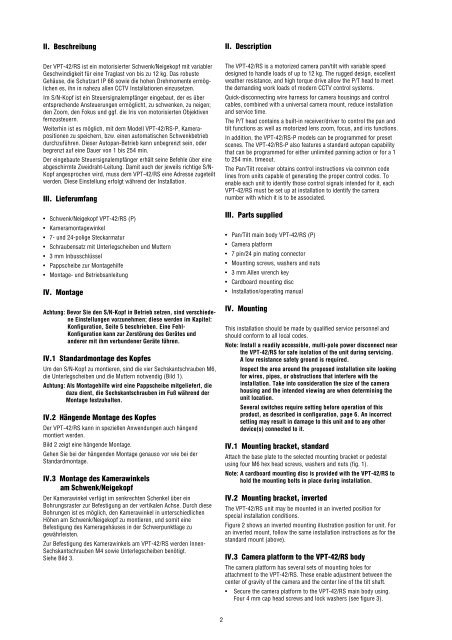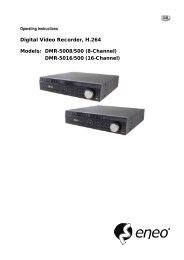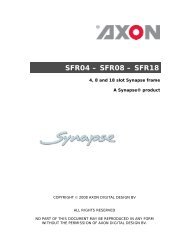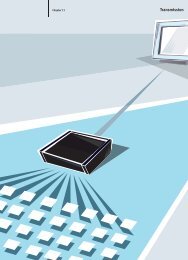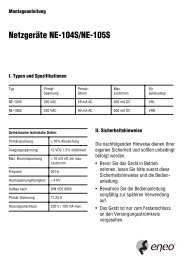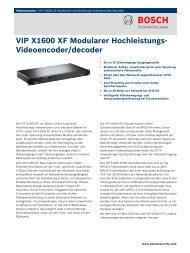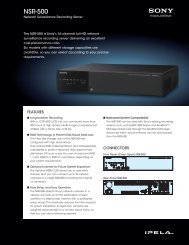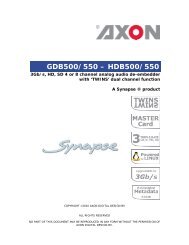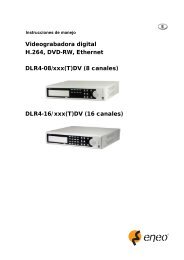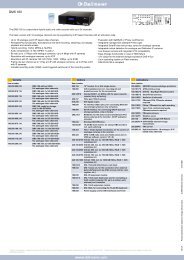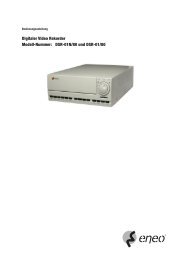VPT-42/RS Schwenk/Neigekopf mit variabler ... - Videor
VPT-42/RS Schwenk/Neigekopf mit variabler ... - Videor
VPT-42/RS Schwenk/Neigekopf mit variabler ... - Videor
Sie wollen auch ein ePaper? Erhöhen Sie die Reichweite Ihrer Titel.
YUMPU macht aus Druck-PDFs automatisch weboptimierte ePaper, die Google liebt.
II. Beschreibung<br />
Der <strong>VPT</strong>-<strong>42</strong>/<strong>RS</strong> ist ein motorisierter <strong>Schwenk</strong>/<strong>Neigekopf</strong> <strong>mit</strong> <strong>variabler</strong><br />
Geschwindigkeit für eine Traglast von bis zu 12 kg. Das robuste<br />
Gehäuse, die Schutzart IP 66 sowie die hohen Drehmomente ermöglichen<br />
es, ihn in nahezu allen CCTV Installationen einzusetzen.<br />
Im S/N-Kopf ist ein Steuersignalempfänger eingebaut, der es über<br />
entsprechende Ansteuerungen ermöglicht, zu schwenken, zu neigen;<br />
den Zoom, den Fokus und ggf. die Iris von motorisierten Objektiven<br />
fernzusteuern.<br />
Weiterhin ist es möglich, <strong>mit</strong> dem Modell <strong>VPT</strong>-<strong>42</strong>/<strong>RS</strong>-P, Kamerapositionen<br />
zu speichern, bzw. einen automatischen <strong>Schwenk</strong>betrieb<br />
durchzuführen. Dieser Autopan-Betrieb kann unbegrenzt sein, oder<br />
begrenzt auf eine Dauer von 1 bis 254 min.<br />
Der eingebaute Steuersignalempfänger erhält seine Befehle über eine<br />
abgeschirmte Zweidraht-Leitung. Da<strong>mit</strong> auch der jeweils richtige S/N-<br />
Kopf angesprochen wird, muss dem <strong>VPT</strong>-<strong>42</strong>/<strong>RS</strong> eine Adresse zugeteilt<br />
werden. Diese Einstellung erfolgt während der Installation.<br />
III. Lieferumfang<br />
• <strong>Schwenk</strong>/<strong>Neigekopf</strong> <strong>VPT</strong>-<strong>42</strong>/<strong>RS</strong> (P)<br />
• Kameramontagewinkel<br />
• 7- und 24-polige Steckarmatur<br />
• Schraubensatz <strong>mit</strong> Unterlegscheiben und Muttern<br />
• 3 mm Inbusschlüssel<br />
• Pappscheibe zur Montagehilfe<br />
• Montage- und Betriebsanleitung<br />
IV. Montage<br />
Achtung: Bevor Sie den S/N-Kopf in Betrieb setzen, sind verschiedene<br />
Einstellungen vorzunehmen; diese werden im Kapitel:<br />
Konfiguration, Seite 5 beschrieben. Eine Fehl-<br />
Konfiguration kann zur Zerstörung des Gerätes und<br />
anderer <strong>mit</strong> ihm verbundener Geräte führen.<br />
IV.1 Standardmontage des Kopfes<br />
Um den S/N-Kopf zu montieren, sind die vier Sechskantschrauben M6,<br />
die Unterlegscheiben und die Muttern notwendig (Bild 1).<br />
Achtung: Als Montagehilfe wird eine Pappscheibe <strong>mit</strong>geliefert, die<br />
dazu dient, die Sechskantschrauben im Fuß während der<br />
Montage festzuhalten.<br />
IV.2 Hängende Montage des Kopfes<br />
Der <strong>VPT</strong>-<strong>42</strong>/<strong>RS</strong> kann in speziellen Anwendungen auch hängend<br />
montiert werden.<br />
Bild 2 zeigt eine hängende Montage.<br />
Gehen Sie bei der hängenden Montage genauso vor wie bei der<br />
Standardmontage.<br />
IV.3 Montage des Kamerawinkels<br />
am <strong>Schwenk</strong>/<strong>Neigekopf</strong><br />
Der Kamerawinkel verfügt im senkrechten Schenkel über ein<br />
Bohrungsraster zur Befestigung an der vertikalen Achse. Durch diese<br />
Bohrungen ist es möglich, den Kamerawinkel in unterschiedlichen<br />
Höhen am <strong>Schwenk</strong>/<strong>Neigekopf</strong> zu montieren, und so<strong>mit</strong> eine<br />
Befestigung des Kameragehäuses in der Schwerpunktlage zu<br />
gewährleisten.<br />
Zur Befestigung des Kamerawinkels am <strong>VPT</strong>-<strong>42</strong>/<strong>RS</strong> werden Innen-<br />
Sechskantschrauben M4 sowie Unterlegscheiben benötigt.<br />
Siehe Bild 3.<br />
2<br />
II. Description<br />
The <strong>VPT</strong>-<strong>42</strong>/<strong>RS</strong> is a motorized camera pan/tilt with variable speed<br />
designed to handle loads of up to 12 kg. The rugged design, excellent<br />
weather resistance, and high torque drive allow the P/T head to meet<br />
the demanding work loads of modern CCTV control systems.<br />
Quick-disconnecting wire harness for camera housings and control<br />
cables, combined with a universal camera mount, reduce installation<br />
and service time.<br />
The P/T head contains a built-in receiver/driver to control the pan and<br />
tilt functions as well as motorized lens zoom, focus, and iris functions.<br />
In addition, the <strong>VPT</strong>-<strong>42</strong>/<strong>RS</strong>-P models can be programmed for preset<br />
scenes. The <strong>VPT</strong>-<strong>42</strong>/<strong>RS</strong>-P also features a standard autopan capability<br />
that can be programmed for either unli<strong>mit</strong>ed panning action or for a 1<br />
to 254 min. timeout.<br />
The Pan/Tilt receiver obtains control instructions via common code<br />
lines from units capable of generating the proper control codes. To<br />
enable each unit to identify those control signals intended for it, each<br />
<strong>VPT</strong>-<strong>42</strong>/<strong>RS</strong> must be set up at installation to identify the camera<br />
number with which it is to be associated.<br />
III. Parts supplied<br />
• Pan/Tilt main body <strong>VPT</strong>-<strong>42</strong>/<strong>RS</strong> (P)<br />
• Camera platform<br />
• 7 pin/24 pin mating connector<br />
• Mounting screws, washers and nuts<br />
• 3 mm Allen wrench key<br />
• Cardboard mounting disc<br />
• Installation/operating manual<br />
IV. Mounting<br />
This installation should be made by qualified service personnel and<br />
should conform to all local codes.<br />
Note: Install a readily accessible, multi-pole power disconnect near<br />
the <strong>VPT</strong>-<strong>42</strong>/<strong>RS</strong> for safe isolation of the unit during servicing.<br />
A low resistance safety ground is required.<br />
Inspect the area around the proposed installation site looking<br />
for wires, pipes, or obstructions that interfere with the<br />
installation. Take into consideration the size of the camera<br />
housing and the intended viewing are when determining the<br />
unit location.<br />
Several switches require setting before operation of this<br />
product, as described in configuration, page 6. An incorrect<br />
setting may result in damage to this unit and to any other<br />
device(s) connected to it.<br />
IV.1 Mounting bracket, standard<br />
Attach the base plate to the selected mounting bracket or pedestal<br />
using four M6 hex head screws, washers and nuts (fig. 1).<br />
Note: A cardboard mounting disc is provided with the <strong>VPT</strong>-<strong>42</strong>/<strong>RS</strong> to<br />
hold the mounting bolts in place during installation.<br />
IV.2 Mounting bracket, inverted<br />
The <strong>VPT</strong>-<strong>42</strong>/<strong>RS</strong> unit may be mounted in an inverted position for<br />
special installation conditions.<br />
Figure 2 shows an inverted mounting illustration position for unit. For<br />
an inverted mount, follow the same installation instructions as for the<br />
standard mount (above).<br />
IV.3 Camera platform to the <strong>VPT</strong>-<strong>42</strong>/<strong>RS</strong> body<br />
The camera platform has several sets of mounting holes for<br />
attachment to the <strong>VPT</strong>-<strong>42</strong>/<strong>RS</strong>. These enable adjustment between the<br />
center of gravity of the camera and the center line of the tilt shaft.<br />
• Secure the camera platform to the <strong>VPT</strong>-<strong>42</strong>/<strong>RS</strong> main body using.<br />
Four 4 mm cap head screws and lock washers (see figure 3).


